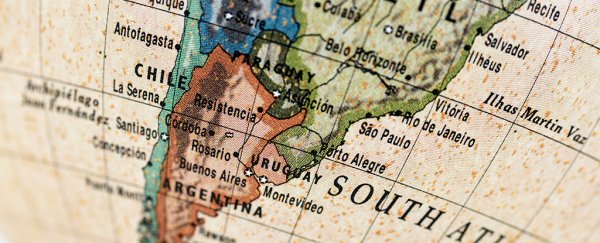In spite of its location midway down the eastern seaboard of the continent of South America, Uruguay's brief history is a blur of European conflict, shaped by the colonial interests of Spanish, British, and Portuguese powers.
What is starkly missing are voices from prehistory, of indigenous cultures that called the land's rolling hills and temperate plains home for thousands of years.
Echoes of that lost past are finally being heard thanks to the efforts of researchers from the University of the Republic, Montevideo, in Uruguay, and Emory University and Florida Atlantic University in the US.
Their investigation of the remains of two individuals who lived long before Christopher Columbus's famous trans-Atlantic voyage has revealed surprising connections between populations across the Americas. What's more, the findings challenge theories that suggest South America's indigenous people all trace from a single migration.
"This contributes to the idea of South America being a place where multi-regional diversity existed, instead of the monolithic idea of a single Native American race across North and South America," says Emory University anthropologist, John Lindo.
Both sets of remains were uncovered in a 2,000-year-old archeological dig site in Rocha, a coastal city in southeastern Uruguay. One, with two X chromosomes, was estimated to be around 1,400 years old. The other's sex was harder to pin down but appeared to have lived around 650 years ago.
Though separated by centuries, the genetics of each contributed to a larger story of a complex ancestry that connected indigenous Uruguayans with genomes uncovered from ancient Panama – the stretch of land linking South America with the continent to the north – and eastern Brazil.
Following the genetics trail backward through time, the findings could reflect a migration path down from the north, or even a later return migration from the south.
Surprisingly, the couple's genomes didn't appear to be closely related to modern-day Indigenous Amazonian populations.
A most likely explanation for this pattern is a separation of ancestries among South America's spread of indigenous populations.
"It runs counter to the theory of a single migration that split at the foot of the Andes," says Lindo.
Settling the debate once and for all will take a lot more evidence collected from a far wider range of sources, a challenge made all the more difficult by South America's climate.
Unlike Europe, the damp, warm conditions across much of the continent make short work of any DNA nestled inside the bones of the dead.
"If you're of European descent, you can have your DNA sequenced and use that information to pinpoint where your ancestors are from down to specific villages," says Lindo.
"If you are descended from people indigenous to the Americas you may be able to learn that some chunk of your genome is Native American, but it's unlikely that you can trace a direct lineage because there are not enough ancient DNA references available."
Significantly, the loss and displacement of indigenous populations through genocide and slavery also makes the task of tracing the human story prior to the European invasion all the more challenging.
In the case of Uruguay, the final chapter of an ethnic past closed in 1831, when a diverse group of indigenous people broadly identified as the Charrúa met their end at the hands of the state.
By the banks of Salsipuedes Creek, dozens lost their lives, while hundreds were taken into slavery.
Uruguay has lacked an ethnic presence ever since. Though a whisper of DNA hardly makes up for centuries of silence, it's a solid place to start in learning more about how Uruguay's indigenous populations fit into a broader picture.
"Through these first whole genome sequences of the Indigenous people of the region before the arrival of Europeans, we were able to reconstruct at least a small part of their genetic prehistory," Lindo says.
This research was published in PNAS Nexus.
